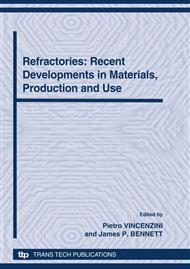p.1
p.9
p.15
p.21
p.30
p.37
p.47
p.53
p.59
Characterisation of the Fracture Path in ‘Flexible’ Refractories
Abstract:
The denomination ‘flexible’ is chosen in the professional jargon of refractories technology for materials able to bear relatively high strains without or with acceptable loss of strength. In many cases this term is equivalent to relatively low brittleness. Characterisation of brittleness based on fracture mechanical investigations may use figures of merit like brittleness numbers, a so called characteristic length or the R’’’’ parameter according to Hasselman. In many cases these figures show that brittleness reduction of refractories is achieved by decrease of strength with at the same time more or less unaffected specific fracture energy. Microscopic investigations of fracture paths aim to exhibit which peculiarities of crack microstructure enable this change of mechanical properties. A microscopical technique developed for this purpose separately evaluates the relative crack lengths along the grain/matrix interface, within the matrix and within the grain. Results obtained for several types of refractories show brittleness decrease is associated by an increase of the relative crack length along the grain/matrix interface and a decrease of transgranular fracture. Prefabricated microcracks and a relatively low grain/matrix bond strength may support this type of crack propagation.
Info:
Periodical:
Pages:
30-36
Citation:
Online since:
October 2010
Authors:
Keywords:
Price:
Сopyright:
© 2010 Trans Tech Publications Ltd. All Rights Reserved
Share:
Citation:


